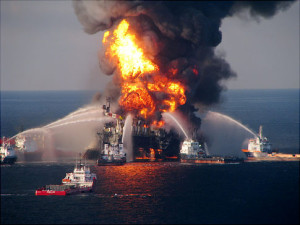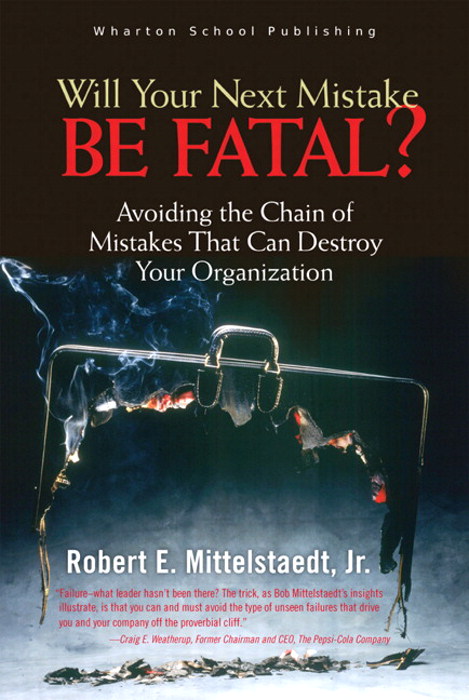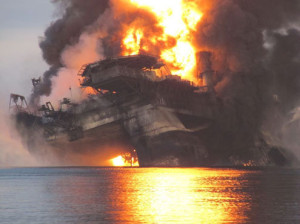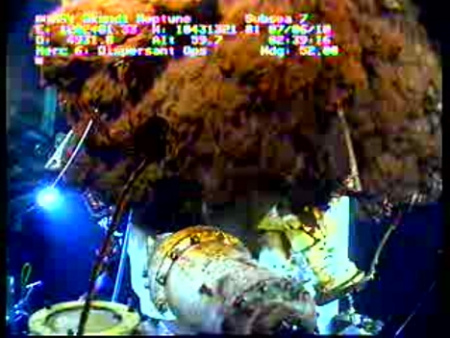BP: Benighted Planning
“Plan for what is difficult when it is most easy,
do what is great while it is small.
The most difficult things in the world must be done
while they are still easy,
the greatest things in the world must be done
while they are still small.”
The Tao-te Ching, or The Way and Its Power
Lao Tzu (604-581 BCE)
….
Let’s simply stipulate that BP’s response to its disaster in the Gulf is shaping up to be the new standard for mishandled crises.
We’ll continue to harvest how-not-to lessons from BP as long as Tony Hayward continues to talk, the oil continues to flow, and beaches, fisheries, wetlands, wildlife, and livelihoods remain at risk.
But what are the deeper lessons?
I believe the key is this: The seeds of what happened after the April 20 explosion were planted well before April 20.
To harvest the most meaningful lessons from BP requires us to look at the sequence of events leading to the fire, explosion, collapse of the rig, death of 11 workers, and the surge of oil into the Gulf.
Prevention More Important Than Response
However important getting crisis response right may be, crisis prevention is even more important.
BP got both spectacularly wrong.
First, BP missed the signs that things were amiss and that a disaster loomed. Second, its purported crisis plan was a patched-together copy-and-paste of prior plans, with no meaningful assessment of the particular challenges of drilling a mile deep, or of an out-of-control gusher in the Gulf of Mexico. It’s no wonder that BP seems to be making the response up as it goes along. It is.
Will Your Next Mistake be Fatal?
Most crises follow predictable patterns, and crisis prevention involves pattern recognition. Early recognition of patterns helps a leadership team adapt and resolve problems before they get worse.
A seminal work in this sort of pattern recognition is Will Your Next Mistake be Fatal?: Avoiding the Chain of Mistakes That Can Destroy Your Organization by Robert E. Mittelstaedt, Jr. Mittelstaedt is Dean and Professor of the W.P. Carey School of Business, Arizona State University, and former Vice Dean and Director of the Aresty Institute of Executive Education at the Wharton School of Business, University of Pennsylvania.
I require my crisis management students in the executive MBA program of the NYU Stern School of Business to master Mittelstaedt. The book puts leaders on notice that they have both more control and more responsibility for their organizations’ destinies than they may imagine.
Red Flags
According to Mittelstaedt, mistakes don’t just happen; they’re allowed to happen, sequentially, and with increasing severity.
Although the specifics may be different, the human behaviors, interpersonal dynamics, and preconceived notions play out in similar ways. Mittelstaedt writes,
“mistakes, both in business and nonbusiness settings across industries, reveal patterns that are so repetitive that every manager should recognize them as potential red flags.”
Such mistake chains often involve some combination of the following:
- Failure to correct a seemingly minor or isolated problem.
- A subsequent problem that compounds the effect of the initial problem.
- An ineffective corrective action.
- Disbelief that the situation is getting out of hand.
- Denial (or self-denial) about the truth of what’s happening.
- Sudden recognition that an extreme situation exists and is out of control.
- The ultimate disaster.
The earlier one can intervene and break the mistake chain, the easier it is to regain a successful course.
Operational Problems, Unattended, Become Strategic Failures
But failure to break the chain causes the damage to increase exponentially. And problems that are initially operational, over time and unattended, become strategic failures.
As in all crisis management, the first and most effective defense is vigilance. Mittelstaedt notes,
“the greatest challenge in most organizations is not figuring out how to fix a problem but recognizing that there’s a problem that needs to be fixed.”
Mental preparation is critical.
Leaders and those they lead need to be taught to recognize patterns of mistakes and to extrapolate implications from other situations to their own.
Among the factors that cause otherwise intelligent and successful leaders to miss predictable crises are:
- Failure to evaluate their own assumptions, about the problem, their own abilities, their customers, their competitors, etc.
- Previous successes that cause leaders to believe in their own invulnerability — and that cause arrogance that interferes with effective decision making.
- Failure to communicate or listen to others both internal and external, who may be calling attention to early problems.
- Lack of standard procedures, or failure to follow existing procedures.
- Cultural barriers, that penalize challenges to prevailing thinking, or that inhibit initiative and information-sharing.
- Ignoring economic laws and cycles.
- Not internalizing lessons from prior failures.
BP’s Mistake Chain
We see just these patterns in the run-up to the April 20 disaster. Although the specifics are still coming out, it’s already clear that warning signs abounded on the Deepwater Horizon.
According to the New York Times, as early as June of 2009, fully 10 months before the blow-out, BP had concerns that the metal casing planned for the rig might collapse under high pressure. Says the Times,
“This would certainly be a worst-case scenario,” Mark E. Hafle, a senior drilling engineer at BP, warned in an internal report. “However, I have seen it happen so I know it can occur.” The company went ahead with the casing, but only after getting special permission from BP colleagues because it violated the company’s safety policies and design standards. The internal report does not explain why the company allowed for an exception.
The Times reviewed more than 50,000 pages of company documents, including engineering reports and internal e-mails. The Times reports,
In March, after problems on the rig that included drilling mud falling into the formation, sudden gas releases known as “kicks” and a pipe falling into the well, BP informed federal regulators that they were struggling with the loss of “well control.” On at least three occasions, BP records indicate, the blowout preventer was leaking fluid, which the manufacturer of the device has said limits its ability to operate properly.
“The most important thing at a time like this is to stop everything and get the operation under control,” said Greg McCormack, director of the Petroleum Extension Service at the University of Texas, Austin, offering his assessment about the documents.
The initial June 2009 failure to follow existing procedures regarding the casing was compounded in April when the company ignored concerns about sealing the casing. According to the Times,
In April of this year, BP engineers concluded that the casing was “unlikely to be a successful cement job,” according to a document, referring to how the casing would be sealed to prevent gases from escaping up the well. The document also says that the plan for casing the well is “unable to fulfill M.M.S. regulations,” referring to the Minerals Management Service.
Further deviations from protocol occurred in testing the blowout preventer, which is supposed to be tested every two weeks. The Times says that BP asked regulators for a delay of such testing, and that initially the regulators refused. They relented, literally at the 11th hour. According to the Times,
When the blowout preventer was eventually tested again, it was tested at a lower pressure — 6,500 pounds per square inch — than the 10,000-pounds-per-square-inch tests used on the device before the delay. It tested at this lower pressure until the explosion.
Aftermath
On April 20 an explosion and fire took the lives of 11 rig workers and injured 17 others. Two days later the Deepwater Horizon rig sank. Since then, millions of barrels of crude have surged into the Gulf of Mexico, one mile below the surface.
Regulations require that those who drill offshore prepare response plans, just in case of a catastrophic development. BP persistently downplayed the risks of such an event, and seems to have merely gone through the motions.
BP filed a 582-page plan for the Gulf of Mexico as a whole, and 52-page plan specific to the Deepwater Horizon drill site. According to an analysis by the Associated Press, the plans
vastly understate the dangers posed by an uncontrolled leak and vastly overstate the company’s preparedness to deal with one.
The Deepwater Horizon site plan was explicit about BP’s capabilities:
BP has the capacity to respond, to the maximum extent practicable, to a worst case discharge, or the substantial threat of such a discharge, resulting from the activities proposed in our Exploration Plan.
For example, BP said it had sufficient watercraft with skimming technology to remove 20 million gallons of oil from water each day.
In addition to BP’s capabilities, other factors would mitigate harm. For example, the site plan said that coastal areas were unlikely to be affected by a major spill:
Due to the distance to shore (48 miles) and the response capabilities that would be implemented, no significant adverse impacts are anticipated.
The site plan also predicted no adverse impact on wildlife: birds, turtles, or marine mammals.
I Am the Walrus
And it is in reference to marine mammals that the site plan exposed its true nature: a copy-and-paste from other plans, without even cursory attempts to customize the plan for the Gulf of Mexico.
The site plan, for example, lists the kinds of marine mammals that might be affected by a spill: Otters, sea lions, seals, and walruses. None of these species can be found in the Gulf of Mexico. They are residents of very cold environments, such as Alaska.
Another telling detail: BP’s 2009 Gulf of Mexico spill response plan lists professor Peter Lutz as its national wildlife expert, saying he’s a professor at the University of Miami. But professor Lutz left Miami 20 years ago for Florida Atlantic University in Boca Raton. And he died in 2005.
The Associated Press says that the plan also lists incorrect names and phone numbers for several Texas A&M University marine wildlife experts. And it lists marine mammal stranding network offices in Louisiana and Florida that are no longer in service. And the website listed for Marine Spill Response Corp., which provides BP with response capabilities, links to a defunct Japanese-language page.
Lessons for Leaders
Bad things happen to good companies all the time. Whether a company emerges from a crisis with its reputation, operations, and financial condition intact is based not on the severity of the crisis, but on the timeliness and quality of the response.
One of the burdens of leadership is to assure that your company is ready for things to go wrong. And further to intervene early to prevent those very things from happening.
No Leader Plans to Fail
But Many Fail to Plan
And an effective and timely response can take place only if there’s an effective plan in place. Not just any plan. Simply saying you have a plan; taking an off-the-shelf plan and thinking it will serve; or copying and pasting without regard to the actual situation can be recipes for disaster — witness BP.
An effective plan takes a candid look at scenarios, including unlikely scenarios. But it also looks at the magnitude of each scenario — including the unlikely scenarios. And however unlikely a scenario may be — say, an uncontrolled gushing of oil into the Gulf for months at a time — if the magnitude is significant, there has to be good faith planning to respond effectively to such an event.
Mental preparation is key. One of the advantages of scenario planning is that it sensitizes leaders to the consequences of catastrophes, and also to the causes of catastrophes. Per Mittelstaedt, catastrophes aren’t only the result of major unexpected events, but rather of the predictable accumulation of relatively minor events.
Mittelstaedt says that mistake chains show patterns so predictable that leaders should see them as red flags.
So here’s the burden of leadership — and the failure of leadership at BP: See the patterns, wave the red flag, and stop the mistake chain before it becomes fatal.
I welcome your feedback.
Fred









Leave a Reply
Want to join the discussion?Feel free to contribute!